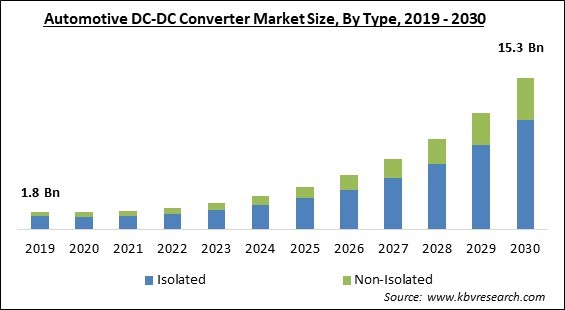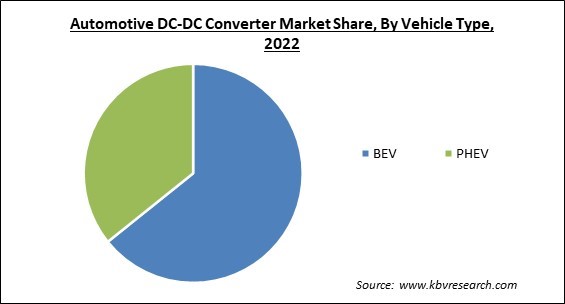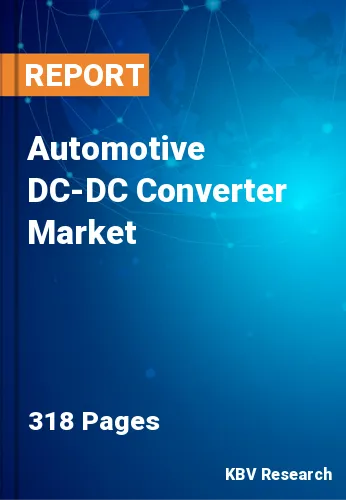The Global Automotive DC-DC Converter Market size is expected to reach $15.3 billion by 2030, rising at a market growth of 28.2% CAGR during the forecast period.In the year 2022, the market attained a volume of 2,231.9 thousand units, experiencing a growth of 10.4% (2019-2022).
Supportive government policies will drive market expansion in Europe in the upcoming years. Hence, Europe segment is anticipated to capture approximately 28% share of the market by 2030. Many European nations provide financial incentives and subsidies to lower the initial cost of buying electric vehicles. These incentives could take advantage of grants, tax reductions, or rebates. For instance, Germany gives "Umweltbonus," a purchasing subsidy that offers buyers of electric vehicles a financial benefit, due to which the market will grow in this region. Some of the factors impacting the market are rising electrification in vehicles, EVs are becoming more prevalent, and varying regional/national regulatory compliance and safety standards.

Automotive original equipment manufacturers (OEMs) are encouraged to incorporate cutting-edge technologies in their vehicle offerings to improve fuel efficiency due to the increasing adoption of strict emission requirements. Electric drivetrains have been developed for medium and heavy commercial vehicles (M&HCVs) due to this trend. As technology advances and infrastructure improves, electric vehicles are expected to play an increasingly prominent role in the automotive industry. Therefore, these developments will increase the demand for DC-DC converters, thereby propelling the growth of the market in the coming years. According to the International Energy Agency (IEA), in 2022, 14% of all new automobiles sold were electric, up from less than 5% in 2020 and roughly 9% in 2021. China led the way, representing around 60% of global sales of electric vehicles. China currently accounts for more than half of all-electric vehicles on the road, and the nation has already surpassed its goal for new energy vehicle sales by 2025. National incentives and programs will boost sales, and a return to last year's extraordinarily high oil prices could further entice potential customers. This market is projected to expand in conjunction with the rising demand for electric vehicles.
However, to prevent harm from occurring to people or property due to potential threats like electric shock, energy hazards, fire, mechanical and heat hazards, radiation hazards, and chemical hazards, several international and domestic regulations and standards have been developed for DC-DC converters. Manufacturers have to spend money on testing, certification, and research and development to ensure their converters fulfill these standards, which can be expensive to comply with. Such factors may hamper the growth of the market in the coming years.
On the basis of type, the market is segmented into isolated and non-isolated. In 2022, the isolated segment dominated the market with the maximum revenue share. To get the required output voltage level, isolated DC-DC converters can step up (boost), down (buck), or invert the input voltage. These are available in various topologies, such as flyback, forward, push-pull, and full-bridge, each with advantages and limitations. These converters usually include a control circuit that modifies the duty cycle of the converter's switching transistors to control the output voltage.
By vehicle type, the market is classified into BEV and PHEV. The PHEV segment recorded a remarkable revenue share in the market in 2022. Plug-in hybrid electric vehicles (PHEVs) that combine gasoline and electricity have an internal combustion engine, a battery, an electric motor, and a gas tank. Gasoline and electricity are also possible fuel sources for PHEVs. PHEVs can operate on gasoline when the battery runs out since they have electric and internal combustion engines (ICEs). This increased range essentially eliminates concerns about battery life running out. PHEVs are better suited for drivers who frequently travel long distances or don't have access to charging infrastructure because they offer more flexibility for longer trips.

Based on application, the market is fragmented into passenger cars and commercial vehicles. In 2022, the passenger cars segment held the highest revenue share in the market. Increased middle-class income and growing consumer interest in environmentally friendly products will drive future passenger car growth. Many nations are trying to lower greenhouse gas emissions and convert to a more environmentally friendly transportation system. Owning an electric vehicle can be considered a sign of an innovative thinking, environmentally conscious mindset that adds to its desirability. To reduce GHG emissions from the automobile sector, car companies, including Tesla, Honda, Hyundai, and Ford, are producing passenger electric vehicles.
| Report Attribute | Details |
|---|---|
| Market size value in 2022 | USD 2.1 Billion |
| Market size forecast in 2030 | USD 15.3 Billion |
| Base Year | 2022 |
| Historical Period | 2019 to 2021 |
| Forecast Period | 2023 to 2030 |
| Revenue Growth Rate | CAGR of 28.2% from 2023 to 2030 |
| Number of Pages | 318 |
| Number of Table | 630 |
| Quantitative Data | Volume in Thousand units; revenue in USD Million, and CAGR from 2019 to 2030 |
| Report coverage | Market Trends, Revenue Estimation and Forecast, Segmentation Analysis, Regional and Country Breakdown, Companies Strategic Developments, Company Profiling |
| Segments covered | Type, Vehicle Type, Application, Region |
| Country scope | US, Canada, Mexico, Germany, UK, France, Russia, Norway, Netherlands, China, Japan, India, South Korea, Singapore, Taiwan, Brazil, Argentina, UAE, Saudi Arabia, South Africa, Nigeria |
| Growth Drivers |
|
| Restraints |
|
Region-wise, the market is analyzed into North America, Europe, Asia Pacific, and LAMEA. In 2022, the Asia Pacific region witnessed the largest revenue share in the market. Due to supportive government policies, expanding charging infrastructure, and technology improvements, the value of the regional market will probably increase. A significant and rapidly expanding middle class with increased purchasing power exists in the Asia Pacific. More consumers consider electric vehicles a feasible alternative as their prices continue to drop and become more competitive with those of internal combustion engine vehicles. There is an increasing interest in cleaner and more sustainable transportation solutions as major cities in developing nations, including China and India, deal with considerable air pollution problems.
The market research report covers the analysis of key stake holders of the market. Key companies profiled in the report include Robert Bosch GmbH, Infineon Technologies AG, Eaton Corporation PLC, BorgWarner Inc., Vicor Corporation, Toyota Industries Corporation, Skyworks Solutions, Inc., Texas Instruments, Inc., Continental AG, and HELLA GmbH & Co. KGaA
Free Valuable Insights: Global Automotive DC-DC Converter Market size to reach USD 15.3 Billion by 2030
By Type(Volume, Thousand Units, USD Million, 2019-2030)
By Vehicle Type(Volume, Thousand Units, USD Million, 2019-2030)
By Application(Volume, Thousand Units, USD Million, 2019-2030)
By Geography(Volume, Thousand Units, USD Million, 2019-2030)
This Market size is expected to reach $15.3 billion by 2030.
Rising electrification in vehicles are driving the Market in coming years, however, Varying regional/national regulatory compliance and safety standards restraints the growth of the Market.
Robert Bosch GmbH, Infineon Technologies AG, Eaton Corporation PLC, BorgWarner Inc., Vicor Corporation, Toyota Industries Corporation, Skyworks Solutions, Inc., Texas Instruments, Inc., Continental AG, and HELLA GmbH & Co. KGaA
The expected CAGR of this Market is 28.2% from 2023 to 2030.
The BEV segment is leading the Market by Vehicle Type in 2022; thereby achieving a market value of $9.6 billion by 2030.
The Asia Pacific region dominated the Market by Region in 2022, and would continue to be a dominant market till 2030; thereby, achieving a market value of $5.9 billion by 2030.
Our team of dedicated experts can provide you with attractive expansion opportunities for your business.

